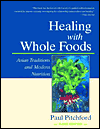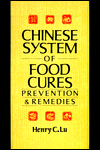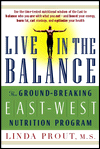Asian nutrition is a large and fascinating topic. In the West, foods are analyzed in terms of their nutrient content — proteins, carbohydrates, fats, vitamins, and minerals. In Chinese medicine, foods are classified according to their energy (hot, cold, cool, warm, neutral), their flavor (sweet, salty, pungent, sour, bitter), and their direction of movement (outward, inward, upward, downward, glossy (sliding), obstructive), among other things.
The various qualities of foods are used to affect corresponding conditions in the body. An individual with symptoms of too much heat (feeling hot, red tongue, high blood pressure, constipation) would be advised to consume cooling foods, such as apples, lettuce, and soymilk. An individual with signs of stagnation in the Liver meridian can benefit from foods (onions) and eating strategies (consume less) that help stimulate the liver out of stagnation.
Note that the links below will open in a second browser window.
|
Healing with Whole Foods, Asian Traditions and Modern Nutrition
by Paul Pitchford
This is the Bible of Asian nutrition, in my opinion. It’s a huge book (750 pages). Part I, The Roots of Diagnosis and Treatment, discusses the assessment of bodily symptoms based on the Eight Principles (hot/cold, yin/yang, excess/deficient, interior/exterior) and includes general dietary recommendations. Part II, Essentials of Nutrition, includes extensive information on water, protein, oils, sweeteners, salt, green food, caffeine, calcium, children, food combining, and much more. Part III relates nutrition to Five Element theory. Part IV is on the dietary treatment of specific disorders. Part V contains recipes and discusses the properties of specific foods.
The book is extremely readable. You can start anywhere and find something fascinating. It’s an excellent reference whenever you’d like to explore alleviating a condition through diet. Note that the hardback edition is no more expensive than the paperback one.
[back to top]
|
|

|
| |
|
|
|
The Book of Jook
by Bob Flaws
Jook is the Cantonese word for Chinese medicinal porridges, traditionally eaten for breakfast. It’s made with a combination of specific grains (usually rice), vegetables, meats, eggs, and Chinese herbs. Cooking the ingredients in a crock-pot overnight is ideal, since this produces a nutrient rich, easily digestible liquid, plus it’s very convenient.
Some of these recipes taste a bit medicinal, so a breakfast that’s exclusively Jook may not be a meal you look forward to. Many of the herbal ingredients are available at the Chinese herb store called Dana Market, next to 800 California Street in Mountain View (just off Castro and around the corner from East West books).
[back to top]
|
|

|
| |
|
|
|

|
|
Chinese System of Food Cures, Prevention and Remedies
by Henry C. Lu
This book includes a brief introduction to the theory of Asian nutrition, but it concentrates primarily on practical applications. For each category of food (fruits, vegetables, meats, spices, etc.), Dr. Lu describes the properties of foods in that category and examples of how best to prepare that food. There’s a chapter on what foods to use to prevent and cure ailments, such as colds, diabetes, hypertension, insomnia, hiccups. There’s also a chapter with Dr. Lu’s personal observations on applying the principles of Asian nutrition to weight loss.
[back to top]
|
| |
|
|
|
|
 |
 |
 |























